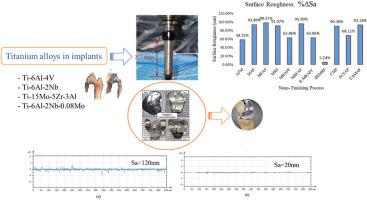Precision Engineering ( IF 3.6 ) Pub Date : 2024-01-31 , DOI: 10.1016/j.precisioneng.2024.01.019 Fadia Ahmed Abdullah Naji , Qasim Murtaza , M.S. Niranjan

|
Nano-finishing processes have revolutionized industrial surface therapy, providing excellent chances to improve surface integrity in various medical sectors. However, in biomedical implants, future expectations and standards for improving surface roughness will rise simultaneously with the growth in demand for artificial implants. Therefore, consistently achieving an appropriate surface finish is still challenging, especially in replacement implant parts like femoral knee, elbow, and hip joints that need a nano level of surface finish according to ISO 7206-2: 2011/AMD 1:2016 standards. This review briefly discusses the utilization of titanium and its alloys in biomedical implants due to its numerous qualities, including great corrosion resistance, superior mechanical capabilities, and excellent biocompatibility. Also, the review presents the most recent and advanced nano-finishing processes used to improve the surface quality of titanium alloys to enhance their functionality and biocompatibility. These advanced nano-finishing processes are systematically presented as mechanical, chemical, and hybrid finishing processes. The remarkable magnetic field-assisted finishing process achieved the lowest surface finish Sa (∼10 nm), an approximately ΔSa 98 % improvement. Further, this review addresses challenges and limitations in the advanced nano-finishing of titanium alloys for biomedical implant applications.
中文翻译:

生物医学应用钛合金纳米精加工的挑战和机遇:综述
纳米精加工工艺彻底改变了工业表面处理,为提高各个医疗领域的表面完整性提供了绝佳的机会。然而,在生物医学植入物中,未来对改善表面粗糙度的期望和标准将随着人工植入物需求的增长而同步提高。因此,始终如一地实现适当的表面光洁度仍然具有挑战性,特别是在股骨膝关节、肘关节和髋关节等替换植入部件中,根据 ISO 7206-2:2011/AMD 1:2016 标准需要纳米级的表面光洁度。本综述简要讨论了钛及其合金在生物医学植入物中的应用,因为钛及其合金具有出色的耐腐蚀性、卓越的机械性能和出色的生物相容性等众多品质。此外,该评论还介绍了用于改善钛合金表面质量以增强其功能和生物相容性的最新和最先进的纳米精加工工艺。这些先进的纳米精加工工艺被系统地表现为机械、化学和混合精加工工艺。卓越的磁场辅助精加工工艺实现了最低的表面光洁度 Sa (∼10 nm),大约 ΔSa 提高了 98%。此外,本综述还讨论了用于生物医学植入物应用的钛合金先进纳米精加工的挑战和限制。



























 京公网安备 11010802027423号
京公网安备 11010802027423号